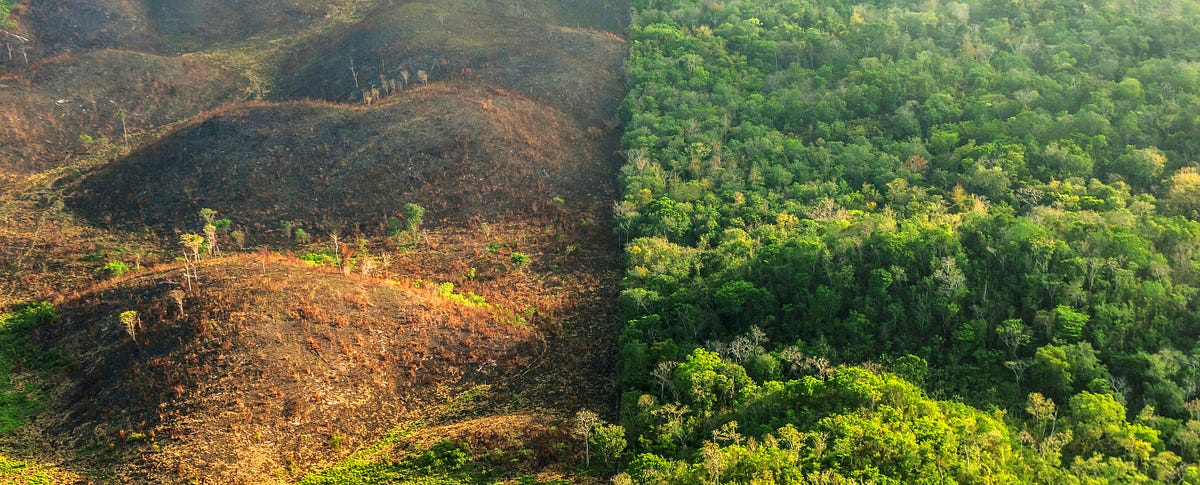
Amazon Rainforest and South American Monsoon
Show Signs of Imminent Co-collapse
George Birchard / Daily Kos
(October 5, 2023) — El Niño and the climate crisis are acting together to bring record drought to Brazil’s Amazonas province. In September over 100 Amazon endangered dolphins died in Lake Tefé in Amazonas fed by superheated 102ºF river water. But this year’s drought is not one of a kind.
Extreme droughts have happened repeatedly since the El Niño of 1997 as the waters of the north Atlantic heat up and the forests of the Amazon are cut down. There were 3 “100 year droughts” in a single decade before the drought this year. The heating of the north Atlantic intensifies convective thunderstorms north of the equator and dry sinking air and strong drying trade winds over the Amazon in the months July to September.
The cutting of trees removes the natural water pump that pulls water out of the ground, evaporates water vapor into the atmosphere and feeds the developing monsoon rains.
The combination of deforestation and warming north Atlantic waters is extending and intensifying the dry season. A new scientific report, that builds on previous reports (that I have written about here), has found multiple warning signs that this combination of deforestation and a warming north Atlantic is about to bring about the coupled collapse of both the South American monsoon and the Amazon rainforest.
The South American monsoon, that brings rain to tropical and subtropical South America, and affects the climate of much of the continent, depends on the rainforest to move moisture that originates in the tropical Atlantic into the heart of the Amazon. When deforestation reaches a critical point water vapor transport into the continent weakens so much that it can no longer support the monsoon and both the monsoon and the rainforest collapse together.
The monsoon and the rainforest are a coupled system. When the forest collapses, the rains that support soy crops, cattle and other agricultural products coming from the Amazon region also fail. Cutting down and burning trees to grow crops will bring on both forest collapse and crop failure.
It’s urgent that we stop Amazon deforestation and began restoration.

Niklas Boers, a professor of Earth system modelling at the Technical University of Munich and the Potsdam Institute, compared the Amazon-coupled monsoon system to a chair that is tilting further and further back to a point where even a breath of wind could knock it over.
“My emotional response is anger,” Boers said. “With every square kilometre of deforestation, every fraction of degree of global warming, we are raising the risk of a tipping point. Yet, it is incredibly simple to just stop deforestation. It is an absolutely unique ecosystem that we really can’t afford to lose.”
Commenting on the paper, Dominick Spracklen, an Amazon expert and professor of environmental science at University of Leeds, said the study was worrying. “This rapid switch to a dry climate would have catastrophic implications for people living in Amazonia,” he wrote. “The study highlights the urgent need for people across Amazonia to work together to find ways to reduce deforestation, prevent further loss of forest and start to restore areas that have been lost in recent years.”
Here’s how the coupled monsoon failure-forest collapse happens according to the climate scientists.

In accordance with our model results, we propose the following chain of mechanisms in the coupled atmosphere-vegetation dynamics on the way to the deforestation-induced transition. The time needed to initiate the wet season prolongs as the atmospheric moisture and, hence, the average latent heat over the Amazon decreases with proceeding forest loss in the east. Large parts of Amazonia show a negative trend in atmospheric moisture content over the past decades (25).
The heating gradient between the Atlantic Ocean and the continent weakens and impedes the annual transition into the wet season (44). Consistently, we observe increasing DSL and later wet season onset in the ERA5 data (Fig. 5B). The shortened wet season and the decreasing rainfall rates result in lower soil moisture levels. Evapotranspiration rates, however, stay at a high level and further deplete the soil during the dry season. This leads to an all-year-round decrease of the soil moisture and an increasing SMD before the dieback of the rainforest.
This increasing SMD can be clearly observed in the ERA5 data (Fig. 5A). After the dieback of the rainforest, the soil moisture approaches an alternative equilibrium consistent with the reduced precipitation and evapotranspiration of the savanna vegetation.
At the critical point, the atmospheric moisture content does not suffice anymore to maintain precipitation and, thus, latent heating rates that could switch the system back into the annual wet season, resulting in a permanent dry season state. Consequently, this would result in a dieback of substantial parts of the rainforest.
The permanent dry state that combined climate warming and Amazon deforestation will bring if we don’t act to stop deforestation and greenhouse gas emissions would affect areas far beyond the Amazon as hotter and dryer air pulled off the Amazon basin would interact with temperate zone storm systems to bring both more extreme storms, more droughts and degraded growing conditions.
Hail storms and severe thunderstorms are intensifying in Argentina because superheated air from the Amazon basin gets pulled south by low pressure systems developing on the lee side of the Andes. This destabilization of the temperate zone in south America is damaging agriculture far away from the Amazon, but is linked to the warming of South America and the Amazon. This study did not examine whether the failure of the monsoon would lead to large scale drying in Argentina or further intensification of severe thunderstorms but either would be damaging to agriculture.
Meanwhile, Tons of Ice Bombs Hit Argentina!